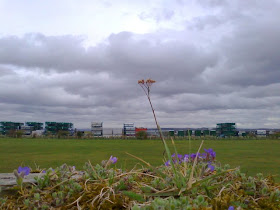This is an extract from a 1950 article by the science editor of the New York Times. It imagines the Dobson family, living in a suburban American house in "Tottenville" in the year 2000. Some of it is amazingly right or at least not all that far off the mark; some is... not. I dare say that the writer didn't entirely believe all his predictions... .
The Dobson house has light-metal walls only four inches thick. There is a sheet of insulating material an inch or two thick with a casing of sheet metal on both sides.
In the center of this eight-room house is a unit that contains all the utilities: air-conditioning apparatus, plumbing, bathrooms, showers, electric range, electric outlets. Around this central unit the house has been pieced together. Some of it is poured plastic - the floors, for instance. By 2000, wood, brick and stone are ruled out because they are too expensive.
It is a cheap house. With all its furnishings, Joe Dobson paid only $5000 for it. Though it is galeproof and weatherproof, it is built to last only about 25 years. Nobody in 2000 sees any sense in building a house that will last a century.
Everything about the Dobson house is synthetic in the best chemical sense of the term. When Joe Dobson awakens in the morning he uses a depilatory. No soap or safety razor for him. It takes him no longer than a minute to apply the chemical, wipe it off with the bristles and wash his face in plain water.
This Dobson house is not as highly mechanized as you may suppose, chiefly because of the progress made by the synthetic chemists. There are no dish washing machines, for example, because dishes are thrown away after they have been used once, or rather put into a sink where they are dissolved by superheated water. The plastics are derived from such inexpensive raw materials as cottonseed hulls.
When Jane Dobson cleans house she simply turns the hose on everything. Why not? Furniture (upholstery included), rugs, draperies, unscratchable floors - all are made of synthetic fabric or waterproof plastic. After the water has run down a drain in the middle of the floor (later concealed by a rug of synthetic fiber) Jane turns on a blast of hot air and dries everything. A detergent in the water dissolves any resistant dirt. Tablecloths and napkins are made of woven paper yarn so fine that the untutored eye mistakes it for linen. Jane Dobson throws soiled “linen” into the incinerator. Bed sheets are of more substantial stuff, but Jane Dobson has only to hang them up and wash them down with a hose when she puts the bedroom in order.
Cooking as an art is only a memory in the minds of old people. A few die-hards still broil a chicken or roast a leg of lamb, but the experts have developed ways of deep-freezing partially baked cuts of meat. This expansion of the frozen-food industry and the changing gastronomic habits of the nation have made it necessary to install in every home the electronic industrial stove which came out of World War II. Jane Dobson has one of these electronic stoves. In eight seconds a half-grilled frozen steak is thawed; in two minutes more it is ready to serve. It never takes Jane Dobson more than half an hour to prepare what Tottenville considers an elaborate meal of several courses.
Some of the food that Jane Dobson buys is what we miscall “synthetic.” In the middle of the 20th century statisticians were predicting that the world would starve to death because the population was increasing more rapidly than the food supply. By 2000, a vast amount of research has been conducted to exploit principles that were embryonic in the first quarter of the 20th century. Thus sawdust and wood pulp are converted into sugary foods. Discarded paper table “linen” and rayon underwear are bought by chemical factories to be converted into candy.
Of course the Dobsons have a television set. But it is connected with the telephones as well as with the radio receiver, so that when Joe Dobson and a friend in a distant city talk over the telephone they also see each other. Businessmen have television conferences. Each man is surrounded by half a dozen television screens on which he sees those taking part in the discussion. Documents are held up for examination; samples of goods are displayed. In fact, Jane Dobson does much of her shopping by television. Department stores obligingly hold up for her inspection bolts of fabric or show her new styles of clothing.
There's lots more...
PS - oh yes, definitely written by a man!

















































